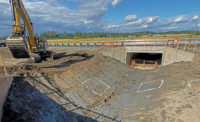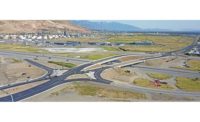

Bold engineering changes cut time, maintained traffic and increased long-term maintenance ease on a $114.6-million upgrade of the Interstate 5/State Route 16 interchange in Tacoma, Wash.
Guy F. Atkinson Construction, Renton, Wash., proposed to change a 1,061-ft-long ramp from one with steel tub girders to a precast segmental structure—a first for the Washington State Dept. of Transportation. Atkinson and value engineer McNary Bergeron and Associates, Old Saybrook, Conn., also redesigned and built, in less than a year, a critical-path temporary bridge with bulb-tee girders rather than steel girders.
The redesigned flyover ramp used a long-line casting bed, allowing crews to start match-casting segments from the pier segment toward the middle on concrete slabs that defined the profile geometry. Using the balanced cantilever method to erect the 70-ton segments minimized falsework and traffic delays on a congested I-5.
Strict seismic demands led crews to build precast shells that, when lowered into place, created an integral pier-column connection completed by a cast-in-place diaphragm pour.
These methods helped crews stay within tight clearances. "Traditional falsework and formwork for supporting the first typical segment and casting these heavy segments in place would have been deep, obtrusive and caused clearance conflicts," says Atkinson field engineer and foreman Bryant Helvey.
Using hydraulic jack arrangements on all corners, crews gained precise 3D adjustments. Jeremy Johannesen, structural engineer with McNary Bergeron, says that extra surveying "was essential in helping us determine the magnitude of the profile adjustments for the new design."
The precast structure is one of the state's first that extensively uses segmental duct couplers, providing extra projection to the post-tensioning at each joint. The design eliminates cost and maintenance of bearings at the interior piers.
Rigorous and extensive safety training resulted in zero lost time hours over three years and 458,700 man-hours.
Key Players
General Contractor: Guy F. Atkinson Construction, Renton, Wash.
Owner: Washington State Dept. of Transportation, Fife, Wash.
Design Firm: Washington State Dept. of Transportation, Olympia, Wash.
Submitted by Guy F. Atkinson Construction






Post a comment to this article
Report Abusive Comment